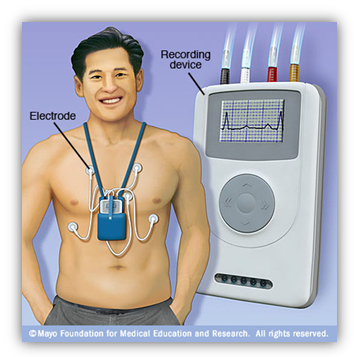A Holter monitor is a small, wearable device that keeps track of your heart rhythm. Your doctor may want you to wear a Holter monitor for one to two days. During that time, the device records all of your heartbeats.A Holter monitor test is usually performed after a traditional test to check your heart rhythm (electrocardiogram) if the electrocardiogram doesn’t give your doctor enough information about your heart’s condition.Your doctor uses information captured on the Holter monitor to figure out if you have a heart rhythm problem. If standard Holter monitoring doesn’t capture your irregular heartbeat, your doctor may suggest a wireless Holter monitor, which can work for weeks.While wearing a Holter monitor may be a little inconvenient, it’s an important test that may help your doctor diagnose your condition

Why It’s Done
If you have signs or symptoms of a heart problem, such as an irregular heartbeat (arrhythmia) or unexplained fainting, your doctor may order a test called an electrocardiogram. An electrocardiogram is a brief, noninvasive test that uses electrodes taped to your chest to check your heart’s rhythm.
However, sometimes an electrocardiogram doesn’t detect any irregularities in your heart rhythm because you’re only hooked up to the machine for a short time. If your signs and symptoms suggest that an occasionally irregular heart rhythm may be causing your condition, your doctor may recommend that you wear a Holter monitor for a day or so.Over that time, the Holter monitor may be able to detect irregularities in your heart rhythm that an electrocardiogram couldn’t detect.Your doctor may also order a Holter monitor if you have a heart condition that increases your risk of an abnormal heart rhythm. Your doctor may suggest you wear a Holter monitor for a day or two, even if you haven’t had any symptoms of an abnormal heartbeat.
Risks
There are no significant risks involved in wearing a Holter monitor other than possible discomfort or skin irritation where the electrodes were placed.
However, the Holter monitor can’t get wet, or it will be damaged. Don’t swim or bathe for the entire time you’re wearing your Holter monitor. However, if you have a wireless Holter monitor, you’ll be shown how to disconnect and reconnect the sensors and the monitor so that you can shower or bathe.
Holter monitors aren’t usually affected by other electrical appliances. But you avoid metal detectors, magnets, microwave ovens, electric blankets, and electric razors and toothbrushes while wearing one because these devices can interrupt the signal from the electrodes to the Holter monitor. Also, keep your cellphones and portable music players at least 6 inches from the monitor for the same reason.
How you Prepare
Just before your Holter monitor test, you’ll have a doctor’s appointment to have the device fitted. You should bathe before this appointment because once your monitoring begins you can’t get the monitor wet or remove the monitor to bathe.
A technician will place electrodes that sense your heartbeat on your chest. These electrodes are about the size of a silver dollar. For men, a small amount of hair may be shaved to make sure the electrodes stick.
The technician will then connect the electrode to a recording device with several wires and will instruct you on how to properly wear the recording device so that it can record data transmitted from the electrodes. The recording device is about the size of a deck of cards.
You’ll be instructed to keep a diary of all the activities you do while wearing the monitor. It’s particularly important to record in the diary any symptoms of palpitations, skipped heartbeats, shortness of breath, chest pain or lightheadedness. You’ll usually be given a form to help you record your activities and any symptoms.
Once your monitor is fitted and you’ve received instructions on how to wear it, you can leave your doctor’s office and resume your normal activities
During the Procedure
Holter monitoring is painless and noninvasive. You can hide the electrodes and wires under your clothes, and you can wear the recording device on your belt or attached to a strap. Once your monitoring begins, don’t take the Holter monitor off — you must wear it at all times, even while you sleep.
While you wear a Holter monitor, you can carry out your usual daily activities. Your doctor will tell you how long you’ll need to wear the monitor. It may vary from 24 to 48 hours, depending on what condition your doctor suspects you have or how frequently you have symptoms of a heart problem. A wireless Holter monitor can work for weeks.
You’ll be asked to keep a diary of all your daily activities while you’re wearing the monitor. Write down what activities you do and exactly what time you do them. You should also write down any symptoms you have while you’re wearing the monitor, such as chest pain, shortness of breath or skipped heartbeats.
Your doctor can compare data from the Holter monitor recorder with your diary, which can help diagnose your condition.
After the procedure
Once your monitoring period is over, you’ll go back to your doctor’s office to return the Holter monitor. A nurse or technician will remove the electrodes from your chest, which may cause some discomfort similar to an adhesive bandage being pulled off your skin.You’ll turn in the diary you kept while you wore the Holter monitor. When the Holter monitor is interpreted, your doctor will compare the data from the recorder and the activities and symptoms you wrote down.
If you have signs or symptoms of a heart problem, such as an irregular heartbeat (arrhythmia) or unexplained fainting, your doctor may order a test called an electrocardiogram. An electrocardiogram is a brief, noninvasive test that uses electrodes taped to your chest to check your heart’s rhythm.
However, sometimes an electrocardiogram doesn’t detect any irregularities in your heart rhythm because you’re only hooked up to the machine for a short time. If your signs and symptoms suggest that an occasionally irregular heart rhythm may be causing your condition, your doctor may recommend that you wear a Holter monitor for a day or so.Over that time, the Holter monitor may be able to detect irregularities in your heart rhythm that an electrocardiogram couldn’t detect.Your doctor may also order a Holter monitor if you have a heart condition that increases your risk of an abnormal heart rhythm. Your doctor may suggest you wear a Holter monitor for a day or two, even if you haven’t had any symptoms of an abnormal heartbeat.
Risks
There are no significant risks involved in wearing a Holter monitor other than possible discomfort or skin irritation where the electrodes were placed.
However, the Holter monitor can’t get wet, or it will be damaged. Don’t swim or bathe for the entire time you’re wearing your Holter monitor. However, if you have a wireless Holter monitor, you’ll be shown how to disconnect and reconnect the sensors and the monitor so that you can shower or bathe.
Holter monitors aren’t usually affected by other electrical appliances. But you avoid metal detectors, magnets, microwave ovens, electric blankets, and electric razors and toothbrushes while wearing one because these devices can interrupt the signal from the electrodes to the Holter monitor. Also, keep your cellphones and portable music players at least 6 inches from the monitor for the same reason.
How you Prepare
Just before your Holter monitor test, you’ll have a doctor’s appointment to have the device fitted. You should bathe before this appointment because once your monitoring begins you can’t get the monitor wet or remove the monitor to bathe.
A technician will place electrodes that sense your heartbeat on your chest. These electrodes are about the size of a silver dollar. For men, a small amount of hair may be shaved to make sure the electrodes stick.
The technician will then connect the electrode to a recording device with several wires and will instruct you on how to properly wear the recording device so that it can record data transmitted from the electrodes. The recording device is about the size of a deck of cards.
You’ll be instructed to keep a diary of all the activities you do while wearing the monitor. It’s particularly important to record in the diary any symptoms of palpitations, skipped heartbeats, shortness of breath, chest pain or lightheadedness. You’ll usually be given a form to help you record your activities and any symptoms.
Once your monitor is fitted and you’ve received instructions on how to wear it, you can leave your doctor’s office and resume your normal activities
During the Procedure
Holter monitoring is painless and noninvasive. You can hide the electrodes and wires under your clothes, and you can wear the recording device on your belt or attached to a strap. Once your monitoring begins, don’t take the Holter monitor off — you must wear it at all times, even while you sleep.
While you wear a Holter monitor, you can carry out your usual daily activities. Your doctor will tell you how long you’ll need to wear the monitor. It may vary from 24 to 48 hours, depending on what condition your doctor suspects you have or how frequently you have symptoms of a heart problem. A wireless Holter monitor can work for weeks.
You’ll be asked to keep a diary of all your daily activities while you’re wearing the monitor. Write down what activities you do and exactly what time you do them. You should also write down any symptoms you have while you’re wearing the monitor, such as chest pain, shortness of breath or skipped heartbeats.
Your doctor can compare data from the Holter monitor recorder with your diary, which can help diagnose your condition.
After the procedure
Once your monitoring period is over, you’ll go back to your doctor’s office to return the Holter monitor. A nurse or technician will remove the electrodes from your chest, which may cause some discomfort similar to an adhesive bandage being pulled off your skin.You’ll turn in the diary you kept while you wore the Holter monitor. When the Holter monitor is interpreted, your doctor will compare the data from the recorder and the activities and symptoms you wrote down.
Cardiac Specialty Care
• Structural Heart Disease
• TAVR
• CardioMEMS (Heart Failure)
• PFO Closure
• TAVR
• CardioMEMS (Heart Failure)
• PFO Closure
• Coronary Intervention
• Complex Higher-Risk (And Indicated) Patients (CHIP) Angioplasty
• Atherectomy
• Impella and ECMO Support
• Complex Higher-Risk (And Indicated) Patients (CHIP) Angioplasty
• Atherectomy
• Impella and ECMO Support
• Peripheral Angioplasty
• Varicose Vein Treatment (Venous Ablation)
• DVT thrombectomy - IVC filter
• Carotid Stenting
• Varicose Vein Treatment (Venous Ablation)
• DVT thrombectomy - IVC filter
• Carotid Stenting
• Rhythm Management
• Pacemaker
• Holter Monitoring
• Exercise Stress Test
• Echocardiography
• Nuclear Stress Test
• Enhanced External Counterpulsation (EECP)
• Pacemaker
• Holter Monitoring
• Exercise Stress Test
• Echocardiography
• Nuclear Stress Test
• Enhanced External Counterpulsation (EECP)
